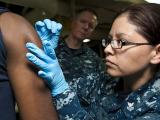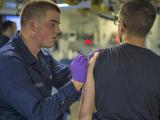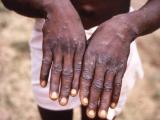Feb 27, 2003 (CIDRAP News) – The civilian smallpox vaccination program has had its first significant adverse event after more than 7,000 shots, a case of suspected generalized vaccinia in a 39-year-old nurse in Florida, according to the Centers for Disease Control and Prevention (CDC).
The agency also reported that a 60-year-old Florida man experienced angina 4 days after he was vaccinated, but it was considered probably unrelated to the shot. In addition, a CDC official confirmed a report that another Florida resident was hospitalized with an acute gallbladder inflammation after being vaccinated, but no other information about the case was available.
The nurse, a woman, was one of 7,354 civilian healthcare and public health workers who received smallpox shots between Jan 24 and Feb 21. The CDC reported her case in the Feb 28 issue of Morbidity and Mortality Weekly Report, released online today, and Dr. Eric Mast, a CDC immunization expert, commented on the case in a telephone news conference today.
The woman's case was labeled a "moderate-to-severe" event. Nine days after getting the shot, she reported increased pain at the vaccination site, malaise, and headache. The next day, "she developed a pruritic, papular rash on her chest and back that progressed to scattered pustules by day 12 following vaccination," the MMWR report says. She received outpatient treatment with antihistamines, and the rash was healing by day 15. Results of virologic testing of clinical specimens were pending, the report says.
"If we isolate virus from the lesions, it'll be a confirmed case," said Mast in today's briefing. He said her case is "relatively mild" and is not expected to cause scarring, and her other symptoms are resolving. "She missed some work but I don't know how much, and at this time there's no evidence of any patients at risk" for contracting the vaccinia virus from her, he commented.
The woman's case was reported within the past week by a physician who called the CDC's 800 number for clinician reporting of vaccine-related adverse events, Mast said.
The angina case was also reported within the past week, Mast said. "Angina is not known to be associated with smallpox vaccination . . . so it's unlikely that [the case] would be associated with smallpox vaccination," he said. The MMWR report says the patient had a history of exertional chest pain, hypertension, and hyperlipidemia, plus a family history of heart disease. The man had chest pain while playing tennis 4 days after his vaccination; he was found to have a coronary artery blockage and underwent angioplasty.
Mast said the CDC does not plan to attempt special testing to assess whether the man's angina was related to the inoculation. "Because the patient's recovered and is home, you'd have to do invasive studies to be able to do that, and we don't plan to do those," he said. He didn't disclose the man's occupation.
Both the woman with possible generalized vaccinia and the angina patient had had previous smallpox shots, Mast reported.
In response to a question, Mast said those two cases were both in Florida. After further questioning about a report of three adverse events in Florida, Mast said the third case there is "an acute gallbladder inflammation in a patient that was hospitalized after vaccination. We heard about this case yesterday evening, but it has not yet been officially reported through to the Vaccine [Adverse] Events Reporting System [VAERS]. It's under investigation and that's all the information that we have about it." He added that gall bladder inflammation has never been associated with smallpox shots before.
No further information about the Florida cases was immediately available from the Florida Department of Health.
Also in MMWR, the CDC said the number of smallpox vaccinees reporting minor adverse events has reached 23. The most common problems and the numbers of people affected included fever, 6; itching, 5; rash, 4; vasodilation, 4; weakness, 3; headache or migraine, 3; malaise, 3; paresthesia, 3; and redness at the injection site, 3.
During the news briefing, Mast was questioned extensively about the CDC's surveillance for smallpox vaccination complications and how the latest adverse events were reported. Clinicians reported both the angina case and the generalized vaccinia case, one through VAERS and one by telephone, he said. But he explained that the CDC is also conducting active surveillance. In that process, people get an identifying number and provide medical information at the time of vaccination. Afterward, they visit monitors who check the vaccination site to determine if the shot "took" and also assess any adverse events. When the follow-up period is over, all vaccinees will be asked to complete a questionnaire about adverse events, Mast said.
In addition, the CDC plans to survey 10,000 vaccinees to collect information about "nonserious" adverse events 10 days and 21 days after vaccination, Mast said. "We expect to start it in about a month," he said.
See also:
CDC. Smallpox vaccine adverse events among civilians—United States, February 18-24, 2003. MMWR 2003;52(8):156-7. Full text:
http://www.cdc.gov/mmwr/preview/mmwrhtml/mm5208a4.htm
CDC telebriefing transcript
http://www.cdc.gov/media/transcripts/t030227.htm




















